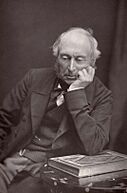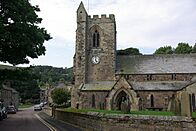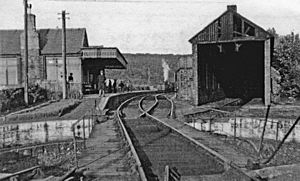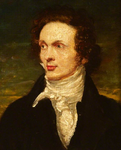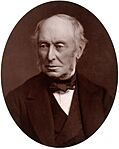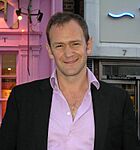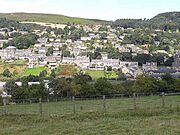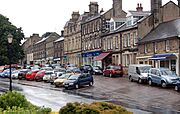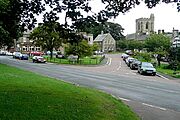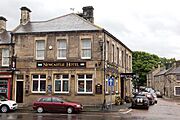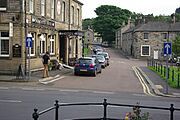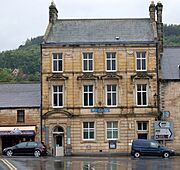Rothbury facts for kids
Quick facts for kids Rothbury |
|
|---|---|
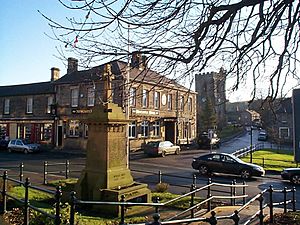 Rothbury town centre |
|
 Looking east along Town Foot |
|
| Population | 2,107 (2011) |
| OS grid reference | NU056017 |
| Civil parish |
|
| Unitary authority |
|
| Ceremonial county | |
| Region | |
| Country | England |
| Sovereign state | United Kingdom |
| Post town | MORPETH |
| Postcode district | NE65 |
| Dialling code | 01669 |
| Police | Northumbria |
| Fire | Northumberland |
| Ambulance | North East |
| EU Parliament | North East England |
| UK Parliament |
|
Rothbury is a lively market town and civil parish in Northumberland, England. It sits right by the River Coquet. The town is about 14 miles (23 km) northwest of Morpeth. It is also about 26 miles (42 km) north of Newcastle upon Tyne. In 2011, about 2,107 people lived there.
Rothbury became an important town because it was a crossroads. It was a place where people could cross the River Coquet using a ford. Roads leading to big towns like Newcastle and Alnwick helped it grow. In 1291, Rothbury was given a special charter. This made it an official market town. It became a hub for trading cattle and wool. Later, Rothbury grew a lot during the Victorian era. This was thanks to the railway and a famous industrialist. His name was Sir William Armstrong. Between 1862 and 1865, Armstrong built Cragside. This was a large country house just outside Rothbury. He made it even bigger and more amazing later on. Today, the National Trust owns Cragside. It is open to visitors and brings many people to the area.
Contents
Exploring Rothbury's Past
Early Times: Before 500 AD
People lived around Rothbury a very long time ago. We know this from things found from the Mesolithic period. These finds include ancient stone tools and other items. There are also signs of early settlements. These include stone piles called cairns. You can also find standing stones and rocks with cup-shaped marks. These are on Debdon Moor, north of the town. There is also a large hillfort to the west. It covers a big area. No signs of the Roman period have been found. This is probably because Rothbury was far north of Hadrian's Wall.
Saxon Era: 500 to 1066 AD
The only old items from before the Norman conquest are parts of an Anglo-Saxon cross. These pieces might be from the 9th century. They were found in 1849 and 1856. This happened when parts of the church were taken down. You can see them now in the town church. Some are also at the University of Newcastle Museum.
Medieval Period: 1066 to 1465 AD
Rothbury was first mentioned in writing around 1100. It was called Routhebiria. This meant "Routha's town." After the Norman conquest, the king owned the village. In 1201, King John signed the Rothbury Town Charter. He visited Rothbury four years later. The rights of the manor of Rothbury were given to Robert Fitz Roger. King Edward I visited in 1291. Fitz Roger then got a charter for a market. It was held every Thursday. There was also a three-day fair each year.
Rothbury was not very big back then. Records from 1310 show it had just a house, a garden, a bakery, and a watermill. These were all rented out. Later, Edward III gave the town to Henry de Percy. This was in 1334. Even with border wars, Rothbury grew richer in the 14th century. By 1535, it was the most valuable parish in Northumberland.
Rothbury became an important town in Coquetdale. It was a crossroads with a ford over the River Coquet. Roads led to big cities like Newcastle and Morpeth. After becoming a market town in 1291, it traded cattle and wool. A market cross was put up in 1722. But it was taken down in 1827. In the 1760s, Rothbury also had small craft businesses. These included hat makers.
Turbulent Times: Border Reivers and Bernard Gilpin
Rothbury has a history with some tough times. In the 15th and 16th centuries, the Coquet valley was a place where Reivers often raided. These groups attacked and burned the town. Hill farming has always been important here. Family names like Armstrong and Robson are still common. Their ancestors were part of these "reiver clans." They often fought with Scottish groups. Many strong, fortified farms called bastle houses still stand. They remind us of these difficult times. These troubles lasted until England and Scotland joined together in 1603.
A famous religious leader named Bernard Gilpin visited Rothbury. He was known as the 'Apostle of the North'. Once, while he was preaching, two rival gangs were about to fight. Gilpin stood between them. He asked them to make peace, and they agreed. Another time, Gilpin saw a glove hanging in the church. He was told it was a challenge for anyone who removed it. Gilpin took the glove and put it in his pocket. No one dared to challenge him. A painting of this event is at Wallington Hall.
Victorian Growth: Cragside and Royal Visits
Rothbury grew a lot during the Victorian era. A big reason for this was Sir William Armstrong. He later became Lord Armstrong of Cragside. He built the amazing country house, Cragside. He started building it in 1862. Then he made it even grander between 1869 and 1900. Cragside and its grounds are now owned by the National Trust. They are open for everyone to visit.
The railway also helped Rothbury grow. Rothbury Station opened in 1870. This brought many tourists who loved walking in the hills. In 1884, the Prince of Wales (who later became King Edward VII) and his wife Princess Alexandra visited Rothbury. They came with their children to see Cragside and Lord Armstrong.
Rothbury in the 21st Century
On November 9, 2006, Prince Charles (now King Charles III) visited Rothbury. He came with his wife Camilla. They reopened the Jubilee Hall. This hall was first built in 1897. It was named after Queen Victoria's Diamond Jubilee. The royal couple also visited Rothbury Family Butchers. The owner, Morris Adamson, said they were very interested in his business. They even sent a thank you letter later!
Community Services
Police and Fire Services
Northumbria Police serves Rothbury. The town has a police station. It moved into a new building in 2019. Rothbury also has a fire station. It is staffed by on-call firefighters. These firefighters are paid to be ready for emergencies. The station has a special four-wheel-drive fire engine.
Healthcare in Rothbury
Rothbury has a doctor's surgery and a hospital. The hospital is called Rothbury Community Hospital. The first building was a private home in 1872. It became a hospital in 1905. New, modern hospital facilities opened in 2007. They were opened by local doctor Angus Armstrong and his son, TV presenter Alexander Armstrong. The hospital stopped taking inpatients in 2016. This caused some local protests.
Rothbury's Location
Rothbury is in Northumberland, England. It is on the River Coquet. It's about 13.5 miles (21.7 km) northwest of Morpeth. It's also 26 miles (42 km) from Newcastle upon Tyne. The town is right on the edge of the Northumberland National Park. Several main roads pass through Rothbury. The B6341 is Rothbury's main street, called Front Street. The B6342 starts in Rothbury and crosses the River Coquet.
Landmarks to See
Rothbury's main church is All Saints' Church. It was mostly built around 1850. But it includes parts of a much older Saxon church. Inside, the church has a special font. Its base is part of an Anglo-Saxon cross. This cross shows what might be the oldest carving of the Ascension of Christ in Great Britain.
Near the church is a market cross. The one you see today was put up in 1902. It was paid for by Lady Armstrong, Lord Armstrong's wife. It is sometimes called "St Armstrong's Cross." Until 1965, Rothbury had a racecourse. It was used for horse racing. But it often flooded, so it closed. Now, the Rothbury Golf Club uses the site.
Half a mile south, you can find Whitton Tower. This is a very old and well-kept 14th-century pele tower. It was built to protect against attacks.
Lordenshaw Hill has many ancient rock carvings. There are over 100 carved panels in a small area. These include rocks with cup marks and complex designs. Other old sites here include an Iron Age enclosure. There is also an Early Bronze Age cairn. Similar to Lordenshaw, there is also a well-preserved Iron Age Fort. It has three circular mounds around it. A 4000-year-old burial cairn is also nearby.
Getting Around Rothbury
Past Railway Station
Rothbury used to have a train station. It was the end of a railway line from Scotsgap. The line opened in 1870. The last passenger trains ran in 1952. The whole line closed in 1963. The old station site is now an industrial area. You can still see one wall of the old engine shed. The old Station Hotel is still there too. It's now called The Coquetvale Hotel. William Armstrong built it in the 1870s. It was a place for visitors to his home, Cragside, to stay.
Bus Services
Today, Rothbury has a bus service called X14. It goes to Longframlington, Morpeth, and Newcastle upon Tyne. The bus runs every two hours during the day. It runs more often during busy morning and evening times.
Education in Rothbury
Rothbury has two schools for young people:
- Rothbury First School is for children aged 3 to 9. It is a state-funded school.
- Dr Thomlinson Church of England Middle School is for children aged 9 to 13. It was founded in 1720. This school is part of The Three Rivers Learning Trust. In 2019, students from this school took part in a School's Climate Strike. They protested about climate change.
After middle school, students often go to The King Edward VI School, Morpeth. This school is also run by The Three Rivers Learning Trust.
Culture and Community Life
Music in Rothbury
Rothbury Traditional Music Festival
Rothbury hosts an annual Traditional music festival. It features concerts and competitions. The music is mainly folk music, especially traditional Northumberland folk music. In 2013, the festival was shown on TV. It was part of Robson Green's show Tales from Northumberland with Robson Green. In 2019, TV presenter and singer Alexander Armstrong, who was born in Rothbury, became a patron of the festival.
Rothbury Hills Tune
There is a tune about Rothbury called "Rothbury Hills." Jack Armstrong wrote it in 1944. Kathryn Tickell has performed it. Alexander Armstrong also wrote and sang lyrics for it on his album "A Year of Songs".
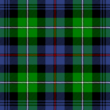
Rothbury Highland Pipe Band
Rothbury has its own pipe band. It is called the Rothbury Highland Pipe Band. It started on June 1, 1920. Back then, it was called the Rothbury Kilted Pipe Band. They chose the Mackenzie tartan for their kilts. This was because some soldiers from the Seaforth Highlanders were stationed nearby during World War One. They became friends with local people. The band reformed in the 1950s and changed its name.
Football Club
Rothbury has its own football club, Rothbury FC. The club plays in Division One of the Northern Football Alliance. This is a local football league.
Local Folklore
In Rothbury folklore, the Simonside Hills have a mythical creature. It is called a deaugar or duergar. This name comes from an old Norse word for dwarf. People say this creature lures people at night. It uses its lantern light to lead them to dangerous bogs or cliffs. The deaugar is now part of Rothbury's popular culture. A local musician wrote a children's book about it. There is also a nighttime trail run called the Duergar Nightcrawler. A Rothbury art gallery is even named Red Deaugar Art Gallery.
Bedlington Terrier Dog
The Bedlington Terrier dog breed was first named after Rothbury. It was known as the Rothbury or Rodbury Terrier. But its name changed. This was because the breed became very popular with miners in the Northumberland village of Bedlington.
Famous People from Rothbury
- William Armstrong, 1st Baron Armstrong (1810–1900) was a famous engineer and industrialist. He lived at Cragside.
- Alexander Armstrong (born 1970) is an actor, comedian, and TV presenter. He was born in Rothbury. He is known for hosting the quiz show Pointless. His father was a doctor in the town.
- Imogen Stubbs (born 1961) is an actress. She was born in Rothbury.
Places Named After Rothbury
- Rothbury, New South Wales, Australia
- North Rothbury, New South Wales, Australia
- Rothbury, Michigan, United States
Gallery
-
Barclays Bank, at the junction of Bridge Street and Town Foot (B6341).





